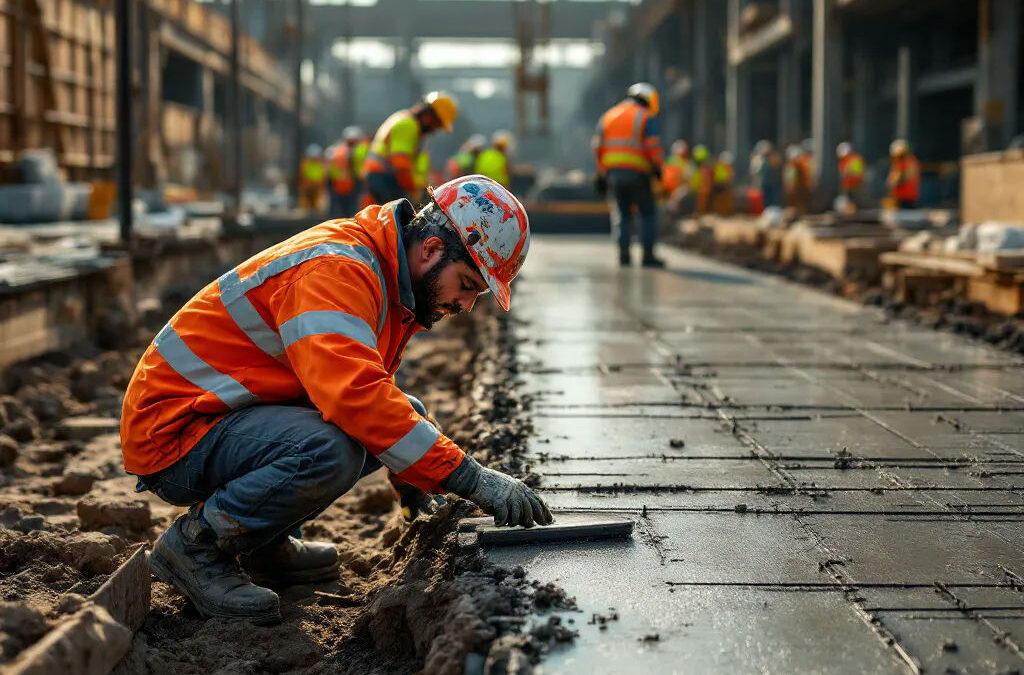I. Introduction
Commercial concrete installation is a critical aspect of modern construction, underpinning everything from retail spaces to office buildings. Understanding the intricacies of this process not only helps in seamless execution but also ensures that the final product meets desired standards of safety and aesthetics. Navigating through this installation journey can be complex, but being informed about each phase aids in making decisions that lead to successful outcomes.
II. Preliminary Planning
A. Site Assessment
Before any concrete is poured, the initial step is a thorough site assessment. Evaluating the construction site involves understanding the landscape, drainage, and any pre-existing structures that could affect installation. Additionally, soil testing and grading considerations are vital; they help determine the soil’s load-bearing capacity and the necessary foundations for different types of structures.
Learn more by reviewing our Pre-Pour Checklist for Large Commercial Concrete Jobs.
B. Project Design
Once the site assessment is complete, the next step involves comprehensive project design. This phase is where decisions about concrete types, finishes, and textures come into play, allowing clients to express their vision. Addressing client specifications ensures that the project aligns with the intended purpose, whether that’s functionality or aesthetic appeal. Dive deeper into how to choose the right concrete mix for your commercial project.
C. Permitting and Regulations
With a well-defined project plan, securing the necessary permits is crucial to avoid legal headaches down the line. Each commercial project typically requires various permits that comply with local building codes and regulations. Understanding these requirements early can expedite the planning phase and help maintain compliance throughout the installation process. To better prepare, don’t miss our article on bidding on commercial concrete jobs profitably.
III. Preparation Phase
A. Site Preparation
Effective site preparation is the backbone of any successful concrete installation. This involves clearing the site of debris, vegetation, and any other obstacles, followed by excavation to create a level surface. Formwork installation is also essential, as it shapes the concrete into specified dimensions and forms during the pouring process.
B. Material Procurement
Material procurement is another critical element that influences the overall functionality of the concrete structures. Sourcing high-quality concrete and reinforcing materials ensures durability and longevity, while verifying material certifications maintains industry standards. A reliable supply chain can make a significant difference in project timelines and quality assurance. Learn more about the importance of reinforcement in commercial concrete work.
IV. Installation Process
A. Pouring Concrete
The installation process begins with pouring concrete, which requires skilled techniques, especially for large volumes. Factors such as temperature and weather must be monitored closely, as they can affect the setting time and overall strength of the concrete. Proper planning and execution during this phase sets the foundation for the entire structure. For more details, see our article on how weather affects commercial concrete pours.
B. Finishing Techniques
Once the concrete is poured, finishing techniques come into play to achieve the desired aesthetics and functionality. Troweling, stamping, and sealing are popular methods that not only enhance appearance but also add a layer of protection against the elements. Each technique involves specific tools and skills, ensuring that the finished product is both beautiful and durable.
C. Curing Process
The curing process is essential for developing concrete strength, ensuring that hydration occurs effectively. Various curing methods, such as covering the surface or using curing compounds, can be utilized based on project requirements and environmental conditions. Monitoring the curing timeline is crucial, as it impacts the overall durability and lifespan of the concrete. Explore more on understanding curing times for commercial concrete projects.
V. Quality Control Measures
A. Inspections During Installation
Quality control measures play a vital role throughout the installation phase. Regular inspections ensure that the installation adheres to project specifications and industry standards, addressing any discrepancies or issues as they arise. This proactive approach helps mitigate potential risks and ensures that the project stays on track. For essential tips, check out our key safety measures for commercial concrete pours.
B. Post-Installation Testing
After installation, post-concrete testing evaluates strength and performance, ensuring compliance with safety regulations. Conducting these tests provides peace of mind and reassurance for stakeholders, confirming that the structure can withstand its intended loads. Additionally, discussing long-term maintenance considerations promotes the longevity of the installation. Avoid common issues with our guide: Top 7 Mistakes to Avoid in Commercial Concrete Construction.
VI. Project Completion
A. Final Inspection and Approval
As the project nears completion, a final inspection becomes crucial to ensure that everything meets the required standards. Stakeholders should conduct a thorough walkthrough and address any punch-list items that may require attention. This final evaluation helps to confirm that the project delivers on the client’s expectations.
B. Handover Process
Once finalized, the handover process involves transferring all relevant documentation and warranties to the client. Educating clients on regular maintenance routines can significantly enhance the structure’s life and performance. Clear communication during this process fosters strong client relationships and transparency. Also, check out our overview of differences between residential and commercial concrete applications.
VII. Conclusion
Navigating the commercial concrete installation process involves several key steps, from preliminary planning to project completion. Each phase requires careful attention to detail and a commitment to quality to ensure successful outcomes. Engaging experienced professionals in concrete installation not only enhances the final product but also offers long-term benefits that contribute to the growth of commercial infrastructure. If you’re planning a commercial concrete project and want expert guidance and quality service, don’t hesitate — call us now at (916) 562-2345 to get a quote!


